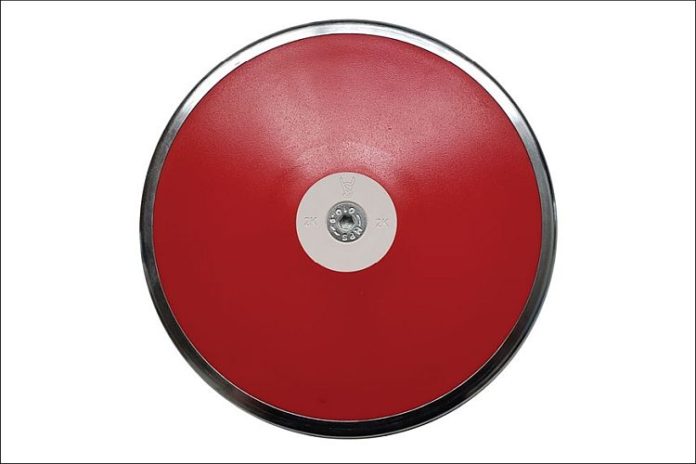★ The Sports Examiner: Chronicling the key competitive, economic and political forces shaping elite sport and the Olympic Movement.★
★ To get The Sports Examiner by e-mail: sign up here! ★
≡ THE 5-RING CIRCUS ≡
1. Alekna had the right setting, wind, and a special discus
2. Skiing great Hirscher to return to Alpine World Cup!
3. Report: $30 million raised for Michael Johnson track league
4. Clark becomes first-ever two-time Sullivan Award winner
5. New transgender study shows mixed results on non-elite cohort
● In addition to perfect wind conditions in Ramona, Oklahoma, Lithuanian record-setter Mykolas Alekna also had an interesting partner in his world record throw: a special, new discus! The story behind the Denfly Skymaster.
● The eight-time FIS Alpine World Cup champion Marcel Hirscher, now 35, wants to return to the slopes, but not for his native Austria, but for Netherlands – his mother’s homeland – beginning with the 2024-25 season.
● A new report says that 1996 Olympic star Michael Johnson has raised $30 million for his proposed, 2025 track “league,” with more details to come in June.
● Another honor and more history for ex-Iowa basketball star Caitlin Clark, who became the first ever to win the AAU Sullivan Award twice, winning in 2023 and 2024, with the announcement made Tuesday in New York.
● A study conducted in England, sponsored by the International Olympic Committee, on transgender and from-birth “athletes” in their mid-30s was designed to show that blanket bans should not be imposed and sport-by-sport studies are needed. But the cohort studied has no relation to Olympic-level athletes and is hard to take seriously.
● World Championship: Curling (Norway and Sweden lead in Mixed Doubles Worlds in Sweden) ●
● Panorama: Paris 2024 (16-year-old arrested for planning Olympic bombing) = Russia (3: Putin aide says athletes will decide for themselves about Paris; RUSADA says 150 doping positives in 2023; new rhythmic gymnastics league presented) = Athletics (Semenya appeal to be re-heard on 15 May) = Shooting (final Olympic Trap qualifier in Doha) = Swimming (U.S. Trials festival program to feature 66-foot-high “Eiffel Tower”) ●
● Errata: Wednesday’s post included an item identifying the start of the Olympic Torch Relay in France as “8 March.” It’s actually 8 May; thanks to reader Paul Roberts for the correction. ●
● Schedule: Due to a scheduling conflict, there will be no post for Friday; we’ll be back on Monday! ●
1.
Alekna had the right setting, wind, and a special discus
The greatest series in discus history came from 21-year-old Lithuanian star Mykolas Alekna on 14 April at the Ramona Throws Festival in Oklahoma, where he parlayed a perfect, quartering wind into a spectacular series of throws, capped by a world record 74.35 m (243-11) in the fifth round.
It was a stunning performance for the University of California’s two-time NCAA scorer, erasing a 38-year old record of 74.08 m (243-0) by Jurgen Schult, competing for a country – East Germany – that doesn’t exist any more.
Alekna was ready, the wind was helpful … and he had a special, added edge: a new discus.
Alekna was throwing the Denfly Skymaster Discus, developed by long-time Danish discus maker Palle Densam, whose models had been sold in the U.S. for decades by Torrance, California-based Springco Athletics, now called VS Athletics.
Densam and Springco had worked together on manufacturing the models sold in the U.S., with the platter itself produced in Denmark and the rims produced in California. Eventually, production moved back to Denmark, but the VS Athletics folks still wanted to sell Densam’s implements and moved to find their own, more accessible source.
Contracting with a foreign manufacturer and perfecting the fabrication process over two years, VS Athletics was finally able to obtain a consistent supply. In the meantime, Densam had designed a new model, the Skymaster, which had a unique, ultra-thin rim. In tests, the VS Athletics team found that the Skymaster – due to its radical rim design – was faster to stabilize in flight, meaning longer throws … in the right hand, of course.
The VS Athletics catalog entry notes that the Skymaster offers “5-8% longer throws than with conventional-rim-weight discus” and a high spin rate of 9-16 revolutions per second on release. It is stated to meet all World Athletics, NCAA and National Federation of High Schools rules.
Alekna proved the idea worked, not just on his record throw, but for the greatest series of all time: 72.21 m (236-11), 70.32 m (230-8), 72.89 m (239-1), 70.51 m (231-4), his world-record 74.35 m (243-11) and 70.50 m (231-3) in round six.
Actually, Alekna had brought three implements with him, with the Denfly Skymaster as a backup, but the other two were not approved during on-site inspection, so he had only one option, but it turned out to be a historic one.
The Denfly Skymaster is available commercially via VS Athletics – it’s one of five Denfly models on sale – in the men’s 2 kg size ($199.95), the high school 1.6 kg size ($189.95) and the women’s 1 kg size ($179.95).
The next time you’re watching the discus, check for the rims!
2.
Skiing great Hirscher to return to Alpine World Cup!
Marcel Hirscher is one of the greatest Alpine skiers of all time. A technical specialist, he won the FIS men’s Alpine World Cup title eight years in a row from 2012-19 and won 67 World Cup races and 138 World Cup medals across 12 seasons for his native Austria.
Now 35, he retired in 2019, but on Wednesday announced he wants to return to the World Cup circuit next season, but skiing for the Netherlands, in honor of his Dutch mother. He said on Instagram:
“For people asking, why are you doing this, for me it’s clear – because the joy of skiing never left, it’s just so much fun for me.”
A change of nationality requires approval by the FIS, but this has been made much easier by the agreement of the Austrian Ski Federation (OSV). In a statement, OSV General Secretary Christian Scherer explained:
“In the last few days there have been discussions with various people involved in which we were informed that Marcel Hirscher could imagine returning to the international ski circuit.
“As the Austrian Ski Association, we have of course tried very hard to offer Marcel the best possible and individual conditions in the event of a return to alpine racing and were able to explain these to him in a personal exchange.
“Of course, we very much regret his decision to request a change of nation to the Dutch Ski Association (Nederlandse Ski Vereniging/NSV), but in the end we supported it. Marcel has done enormous things for skiing and for the ÖSV. In appreciation of this and in the spirit of the internationality of skiing, the ÖSV Presidential Conference unanimously approved his request for a change of association today.”
Hirscher was born in Austria to Austrian father Ferdinand and Dutch mother Sylvia in 1989. He has represented Austria with distinction, winning three Olympic medals (2-1-0) and 11 Worlds medals (7-4-0), primarily in the Slalom and Giant Slalom.
In retirement, he also came out with his own brand of skis, Van Deer, developed in cooperation with his sponsor, Red Bull. He had a conflict over the use of those skis in Austria, as they are not approved equipment for the OSV, but should have no issues with the Dutch federation.
Look for Hirscher to work his way back to the World Cup circuit by competing in lower-level races in New Zealand, but still has to complete the necessary documentation for the transfer to the Dutch federation.
3.
Report: $30 million raised for Michael Johnson track league
Good news for 1996 Atlanta Olympic icon Michael Johnson and his concept for a 2025 track “league,” as the Sports Business Journal reported that his program, coordinated with the Winners Alliance arm of the Professional Tennis Players Association, has raised $30 million in capital.
The story indicated that the league format and other details will be announced in June. Agencies for graphical design, sports marketing and public relations have been hired. Winners Alliance will be the “operational partner.”
The meets are to be held during the spring and summer, but the number, type and format has not been disclosed.
4.
Clark becomes first-ever two-time Sullivan Award winner
Ex-Iowa superstar Caitlin Clark made more history Tuesday evening as the first to win the AAU Sullivan Award twice, selected for a second consecutive year as the nation’s best collegiate or Olympic athlete.
The 94th Sullivan Award winner was announced at the New York Athletic Club, with Clark’s high school coach, Kristin Meyer accepting. Clark appeared by video conference:
“The AAU Sullivan Award is an incredible honor. I have been inspired by so many athletes that came before me and I hope I can be that same inspiration for the next generation to follow their dreams.”
Clark won over five other finalists: Olympic wrestling gold medalist David Taylor, Olympic speed skater Emery Lehman, World Artistic Gymnastics Championships medalist Fred Richard, Texas women’s volleyball star Madisen Skinner, and U.S. Paralympic swimmer Noah Jaffe.
Voting was done by multiple groups, including the public, the AAU Sullivan Award Committee, AAU Board of Directors, sports media, and past winners.
5.
New transgender study shows mixed results on non-elite cohort
A new study comparing “transgender athletes to cisgender athletes,” funded by the International Olympic Committee, concluded – in line with the IOC’s own guidelines – that:
“While longitudinal transitioning studies of transgender athletes are urgently needed, these results should caution against precautionary bans and sport eligibility exclusions that are not based on sport-specific (or sport-relevant) research.”
Posted on 10 April 2024 in the British Journal of Sports Medicine, the study compared small numbers of transgender males against from-birth males and transgender women against from-birth women:
Male cohort:
● 12 transgender males and 19 from-birth males
● Testosterone: 20.5 nmol/L and 24.8 nmol/L
● Handgrip: 38.8 kg and 45.7 kg
● VO2 max: 3635 ml/min and 4467 mL/min
Female cohort:
● 23 transgender females and 21 from-birth females
● Testosterone: 0.7 nmol/L and 0.9 nmol/L
● Handgrip: 40.7 kg and 34.2 kg
● VO2 max: 3682 ml/min and 3226 ml/min
The study participants were recruited via social media – Facebook, Instagram and X – and were tested during a single examination at the University of Brighton in England. All were required to participate in competitive sports or undergo physical training at least three times per week, and transgender participants must have been on testosterone suppression for at least a year.
It’s worth noting that even in this study of non-elite athletes that transgender women had significant advantages in handgrip strength and absolute oxygen capacity (VO2 max).
Observed: While the study opines that the presumed advantages of a transgender woman vis-a-vis a from-birth woman should not be trusted and that more research is needed, it is very difficult for any careful reader to take this study seriously.
Let’s remember that the issue at hand is Olympic- and World Championship-level athletes and the possible advantages of from-birth male athletes who become transgender women vs. from-birth women, such as Penn swimmer Lia Thomas, an undistinguished men’s competitor, who became an NCAA champion in 2022 as a female swimmer.
The study says:
● “No cisgender or transgender athletes were competing at the national or international level.”
● “The results may not apply to all levels or ages of athletes, specifically as this research did not include any adolescent athletes competing at the national or international level.”
Moreover, the age of the male and female “athletes” who were part of this very small testing group confirms that this study has very little to do with athletes at the Olympic or World Championship level:
● Transgender men (12): average age of 34
● From-birth men (19): average age of 37
● Transgender women (23): average age of 34
● From-birth women (21): average age of 30
Remember that these “athletes” were required to work out at least three times a week.
For comparison, a 2016 study of 3,548 high-performing Olympic athletes competing at London in 2012 showed average ages of 27.0 years for men and 26.2 for women. Moreover, 72% of all athletes in that study were between 20-30 years of age.
Across 40 disciplines, men’s averages in 37 out of 40 were at 29.5 years or less and for women, 39 of 40 were under 30 years of age. These folks work out 6-7 days a week and sometimes more than once per day.
The IOC paid for a study whose conclusion reinforces its policy that blanket bans are not acceptable and that only sport-specific studies can establish prudent policies. But the study’s clear miss on testing a meaningful set of subjects – and enough of them – makes it essentially worthless.
≡ WORLD CHAMPIONSHIPS ≡
● Curling ● The World Curling Mixed Doubles Championship in Oestersund (SWE) is nearing the end of round-robin play, with the group leaders Norway (Kristin Skaslien and Magnus Nedregotten: 6-2) and Sweden (Isabella Wrana and brother Rasmus Wrana: 7-0) already qualified for the playoffs.
Pool play finishes Thursday. The top three teams in each pool will move on to the playoffs, currently Switzerland and Estonia on Group A and Canada and South Korea in Group B. The U.S. team of Becca and Matt Hamilton are fourth in Group B (4-3) and still have matches against Canada and the Netherlands ahead of them.
≡ PANORAMA ≡
● Olympic Games 2024: Paris ● The French newspaper Le Parisien reported an arrest of a 16-year-old in Marginier, Haute-Savoie, “suspected of preparing jihadist action during the Olympic Games.
“He was taken into custody by police officers from the General Directorate of Internal Security (DGSI) as part of an investigation taken over by the National Anti-Terrorism Prosecutor’s Office (Pnat) and opened for ‘criminal terrorist association.’”
His activity on the Telegram social-media site alerted officials, with the posts stating a desire to create an explosive device and target the La Defense district during the Games, knowing that he would also be killed.
● Russia ● An influential advisor to Russian President Vladimir Putin has reiterated that Russian athletes who do qualify as neutrals for the Paris 2024 Games can decide for themselves if they will go. Igor Levitin told the Russian news agency TASS:
“The Olympics is a place where athletes represent themselves, not their countries. It is the right of each of them, and if an athlete wants to attend the Olympics, he does so under a neutral flag. But it is very important for him not to sign any documents that denounce the work that our compatriots are doing on the frontline [against Ukraine].”
¶
The number of doping violations by Russian athletes rose to 150 in 2023 vs. 135 in 2022, according to the head of the Russian Anti-Doping Agency, Veronika Loginova. She explained:
“[W]e launched anti-doping inspections of athletes, who either come from a lower echelon or participate only in the country’s regional competitions. In my opinion, this is the main cause behind the increase in reported violations.”
By contrast, the U.S. Anti-Doping Agency lists 44 sanctions – not exactly the same as a gross total of doping violations – for the calendar year 2023.
¶
Continuing the Russian concept of creating their own competitions outside of the International Federations, the head of the Russian Rhythmic Gymnastics Federation, Irina Viner, said in a presentation in Dubai (UAE) that an “International League of Rhythmic Gymnastics Clubs” is being set up to allow competitions outside of the International Gymnastics Federation (FIG).
● Athletics ● The Grand Chamber of the European Court of Human Rights will re-examine the appeal of South Africa’s double Olympic women’s 800 m champion Caster Semenya on 15 May.
A smaller panel of three ECHR judges had ordered the Swiss Federal Tribunal to make a more detailed review of its dismissal of Semenya’s appeal from the Court of Arbitration for Sport, which held that the World Athletics’ regulations discriminated against her, but that it was allowable in order to protect the women’s category of competition.
The Swiss appealed and asked for the Grand Chamber panel, whose ruling will be binding. If Semenya wins, then the case will return to the Swiss Federal Tribunal.
● Shooting ● The final Olympic qualifying tournament for the Shotgun events is taking place in Doha (QAT), with Spain’s 2021 World Junior Trap Champion Andres Garcia winning the final and getting a place at the Paris Olympic Games.
He edged Italy’s already-qualified Mauro de Filippis, 46-45, in the final, with Turkey’s Oguzhan Tuzun third, also getting a Paris qualifier.
In the women’s Trap final, Tokyo champion (and already qualified) Zuzana Rehak Stefecekova (SVK) was a 46-42 winner over Laetisha Scanlan (AUS); the qualifiers for Paris were sixth-place Melanie Couzy (FRA) and Mariya Dmitriyenko (KAZ), who was seventh in the qualifying.
The Skeet competitions come next.
● Ski Jumping ● Japan’s Ryoyu Kobayashi flew an astonishing and all-time best 291 m (954-9) in a specially-arranged event in Hlidarfjall, Iceland, but it won’t count as a world record:
“A ski flying competition must be based on a FIS-certified distance measuring system and take place on a ski flying hill homologated by FIS in order to stand up to comparison with other flights and be eligible for an official ski flying record.
“At the same time, there are regulations for the material that is used and that must be tested by a FIS certified equipment controller; for example, the length of the ski and the mass of the suit.”
The project was a promotional program by Red Bull, but the record remains 253.5 m by Austria’s Stefan Kraft from 2017 at Vikersund, Norway.
● Swimming ● The Indiana Sports Corporation, the host of the U.S. Olympic Trials that will take place at the Lucas Oil Stadium beginning on 15 June, announced its festival program for the Trials, including a 66-foot-high replica of the Eiffel Tower and a concert series for all nine nights of the Trials.
The programming for USA Swimming LIVE will start a day before the Trials, on 14 June, from 5-9:30 p.m. and then from 2-7 p.m. on the nine days of swimming. A “Swim Up Bar,” five new artworks made specially for the Trials, the “Shining A Light” salute to veterans, food and beverage vendors and more will be featured.
The locally-made replica Eiffel Tower, which will weigh 19,000 pounds, will be installed on 10 June.
¶
You can receive our exclusive TSX Report by e-mail by clicking here. You can also refer a friend by clicking here, and can donate here to keep this site going.
For our 920-event International Sports Calendar for 2024 and beyond, by date and by sport, click here!


























